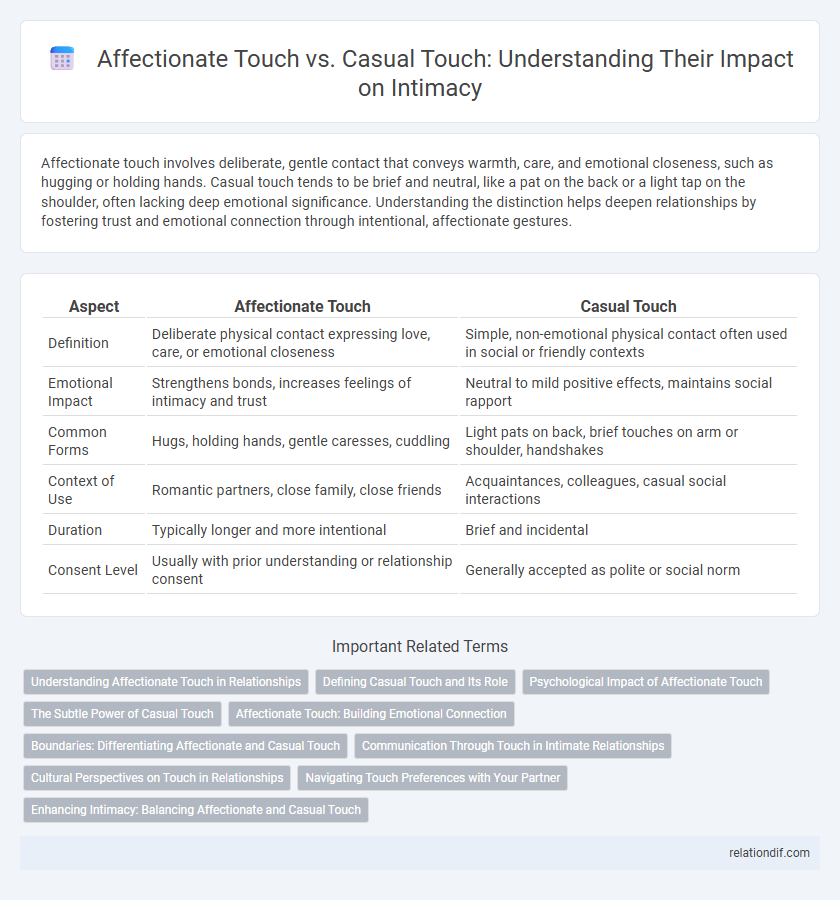Affectionate touch involves deliberate, gentle contact that conveys warmth, care, and emotional closeness, such as hugging or holding hands. Casual touch tends to be brief and neutral, like a pat on the back or a light tap on the shoulder, often lacking deep emotional significance. Understanding the distinction helps deepen relationships by fostering trust and emotional connection through intentional, affectionate gestures.
Table of Comparison
| Aspect | Affectionate Touch | Casual Touch |
|---|---|---|
| Definition | Deliberate physical contact expressing love, care, or emotional closeness | Simple, non-emotional physical contact often used in social or friendly contexts |
| Emotional Impact | Strengthens bonds, increases feelings of intimacy and trust | Neutral to mild positive effects, maintains social rapport |
| Common Forms | Hugs, holding hands, gentle caresses, cuddling | Light pats on back, brief touches on arm or shoulder, handshakes |
| Context of Use | Romantic partners, close family, close friends | Acquaintances, colleagues, casual social interactions |
| Duration | Typically longer and more intentional | Brief and incidental |
| Consent Level | Usually with prior understanding or relationship consent | Generally accepted as polite or social norm |
Understanding Affectionate Touch in Relationships
Affectionate touch in relationships conveys emotional closeness and strengthens bonds through intentional physical contact like hugging, hand-holding, or gentle stroking. Unlike casual touch, which is often brief and functional, affectionate touch releases oxytocin, promoting trust and reducing stress between partners. Recognizing these subtle differences deepens emotional intimacy and supports healthier, more connected relationships.
Defining Casual Touch and Its Role
Casual touch refers to non-intimate physical contact such as handshakes, pats on the back, or brief shoulder touches that facilitate social bonding without conveying romantic or sexual intent. It plays a critical role in establishing trust and comfort in interpersonal relationships by signaling friendliness and approachability. This form of touch helps maintain social cohesion and reduces stress through the release of oxytocin and other neurochemicals.
Psychological Impact of Affectionate Touch
Affectionate touch, such as hugging or gentle caressing, significantly enhances emotional bonding and releases oxytocin, which reduces stress and promotes feelings of safety and trust. Unlike casual touch, which may be neutral or impersonal, affectionate touch directly influences mental health by lowering anxiety and fostering deeper interpersonal connections. This type of tactile interaction plays a crucial role in psychological well-being and relationship satisfaction.
The Subtle Power of Casual Touch
Casual touch, such as a light pat on the back or a brief handshake, holds subtle power in building rapport and trust without overwhelming emotional intensity. Unlike affectionate touch, casual touch can signal openness and approachability, making it effective in both social and professional settings. Neurobiological research shows that casual touch activates oxytocin release, promoting feelings of bonding and cooperation even in brief encounters.
Affectionate Touch: Building Emotional Connection
Affectionate touch, such as gentle caresses or warm embraces, plays a crucial role in building emotional connection by releasing oxytocin, the bonding hormone. Unlike casual touch, which is often functional or polite, affectionate touch fosters trust, reduces stress, and deepens intimacy between partners. This type of touch strengthens relationship satisfaction by signaling care, safety, and mutual affection.
Boundaries: Differentiating Affectionate and Casual Touch
Affectionate touch involves intentional, meaningful physical contact that conveys emotional closeness and trust, such as hugs or gentle strokes between partners or close friends. Casual touch typically occurs in less intimate settings, like a light pat on the back or a handshake, and respects personal boundaries without implying deeper emotional connection. Understanding and respecting these boundaries ensures that affectionate touch fosters comfort and consent, while casual touch maintains appropriate social distance.
Communication Through Touch in Intimate Relationships
Affectionate touch, such as gentle caresses or warm embraces, conveys deep emotional connection and support, enhancing bonding and trust in intimate relationships. Casual touch, including brief pats or light handshakes, serves social functions but often lacks the emotional depth needed to strengthen intimacy. Effective communication through touch relies on context, frequency, and individual preferences, making affectionate touch a crucial nonverbal language for expressing love and reassurance.
Cultural Perspectives on Touch in Relationships
Affectionate touch in relationships often signals emotional closeness and varies widely across cultures, with some societies embracing frequent physical contact as a natural expression of intimacy. Casual touch, such as handshakes or light pats, is commonly accepted in more reserved cultures and serves as a means to maintain social harmony without implying deeper emotional bonds. Understanding these cultural differences is crucial for navigating touch appropriately and fostering healthy interpersonal connections.
Navigating Touch Preferences with Your Partner
Navigating touch preferences with your partner requires understanding the difference between affectionate touch, which conveys emotional closeness and intimacy, and casual touch, typically social and non-romantic. Communicating openly about comfort levels and boundaries ensures both partners feel respected and connected. Tailoring physical interaction to individual preferences strengthens emotional bonds and fosters a deeper sense of trust.
Enhancing Intimacy: Balancing Affectionate and Casual Touch
Balancing affectionate touch, such as gentle caresses and warm embraces, with casual touch like light handshakes or brief pats, enhances intimacy by creating a dynamic connection that feels both safe and engaging. Affectionate touch deepens emotional bonds and signals care, while casual touch maintains comfort and social ease, preventing overwhelming intensity. Strategic use of both touch types fosters trust and closeness, essential for sustaining healthy and intimate relationships.
Affectionate touch vs casual touch Infographic

 relationdif.com
relationdif.com